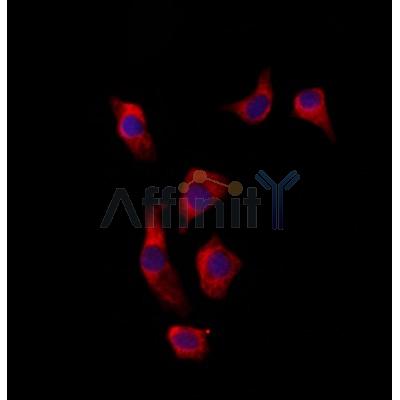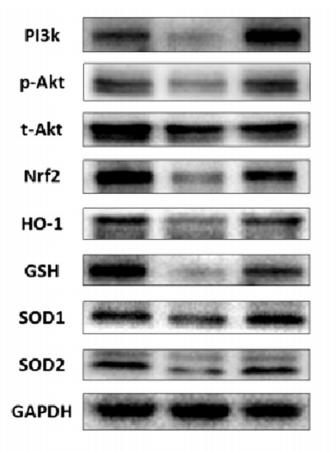GSS Antibody - #DF6214
| Product: | GSS Antibody |
| Catalog: | DF6214 |
| Description: | Rabbit polyclonal antibody to GSS |
| Application: | WB IHC IF/ICC |
| Cited expt.: | WB |
| Reactivity: | Human, Mouse, Rat, Monkey |
| Prediction: | Pig, Zebrafish, Bovine, Horse, Sheep, Rabbit, Dog, Chicken, Xenopus |
| Mol.Wt.: | 52kDa; 52kD(Calculated). |
| Uniprot: | P48637 |
| RRID: | AB_2838180 |
Related Downloads
Protocols
Product Info
*The optimal dilutions should be determined by the end user. For optimal experimental results, antibody reuse is not recommended.
*Tips:
WB: For western blot detection of denatured protein samples. IHC: For immunohistochemical detection of paraffin sections (IHC-p) or frozen sections (IHC-f) of tissue samples. IF/ICC: For immunofluorescence detection of cell samples. ELISA(peptide): For ELISA detection of antigenic peptide.
Cite Format: Affinity Biosciences Cat# DF6214, RRID:AB_2838180.
Fold/Unfold
epididymis secretory sperm binding protein Li 64p; epididymis secretory sperm binding protein Li 88n; Glutathione synthase; Glutathione synthetase; GSH S; GSH synthetase; GSH-S; GSHB_HUMAN; GSHS; GSS; HEL-S-64p; HEL-S-88n; MGC14098; OTTHUMP00000030711;
Immunogens
A synthesized peptide derived from human GSS, corresponding to a region within the internal amino acids.
- P48637 GSHB_HUMAN:
- Protein BLAST With
- NCBI/
- ExPASy/
- Uniprot
MATNWGSLLQDKQQLEELARQAVDRALAEGVLLRTSQEPTSSEVVSYAPFTLFPSLVPSALLEQAYAVQMDFNLLVDAVSQNAAFLEQTLSSTIKQDDFTARLFDIHKQVLKEGIAQTVFLGLNRSDYMFQRSADGSPALKQIEINTISASFGGLASRTPAVHRHVLSVLSKTKEAGKILSNNPSKGLALGIAKAWELYGSPNALVLLIAQEKERNIFDQRAIENELLARNIHVIRRTFEDISEKGSLDQDRRLFVDGQEIAVVYFRDGYMPRQYSLQNWEARLLLERSHAAKCPDIATQLAGTKKVQQELSRPGMLEMLLPGQPEAVARLRATFAGLYSLDVGEEGDQAIAEALAAPSRFVLKPQREGGGNNLYGEEMVQALKQLKDSEERASYILMEKIEPEPFENCLLRPGSPARVVQCISELGIFGVYVRQEKTLVMNKHVGHLLRTKAIEHADGGVAAGVAVLDNPYPV
Predictions
Score>80(red) has high confidence and is suggested to be used for WB detection. *The prediction model is mainly based on the alignment of immunogen sequences, the results are for reference only, not as the basis of quality assurance.
High(score>80) Medium(80>score>50) Low(score<50) No confidence
Research Backgrounds
Belongs to the eukaryotic GSH synthase family.
Research Fields
· Cellular Processes > Cell growth and death > Ferroptosis. (View pathway)
· Metabolism > Amino acid metabolism > Cysteine and methionine metabolism.
· Metabolism > Metabolism of other amino acids > Glutathione metabolism.
· Metabolism > Global and overview maps > Metabolic pathways.
References
Application: WB Species: broilers Sample: liver tissue
Application: WB Species: rat Sample: ventricular
Restrictive clause
Affinity Biosciences tests all products strictly. Citations are provided as a resource for additional applications that have not been validated by Affinity Biosciences. Please choose the appropriate format for each application and consult Materials and Methods sections for additional details about the use of any product in these publications.
For Research Use Only.
Not for use in diagnostic or therapeutic procedures. Not for resale. Not for distribution without written consent. Affinity Biosciences will not be held responsible for patent infringement or other violations that may occur with the use of our products. Affinity Biosciences, Affinity Biosciences Logo and all other trademarks are the property of Affinity Biosciences LTD.






